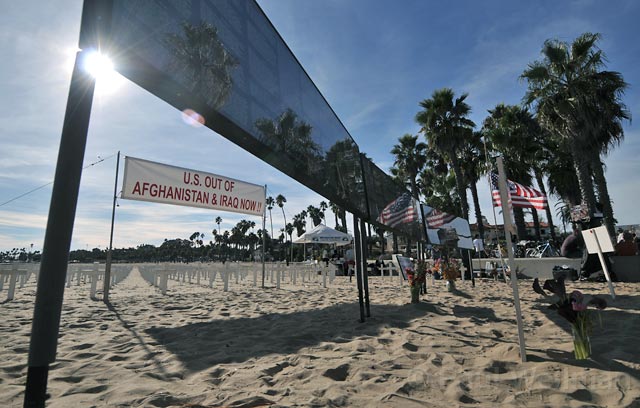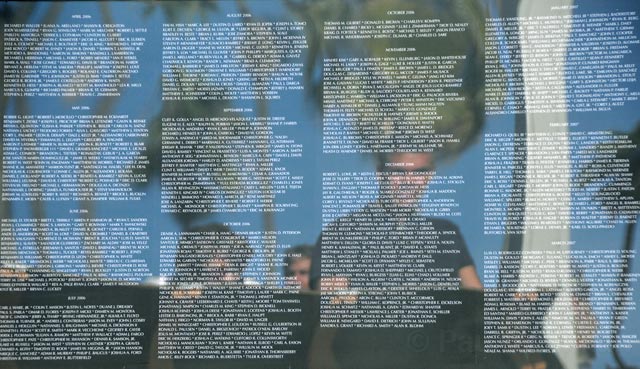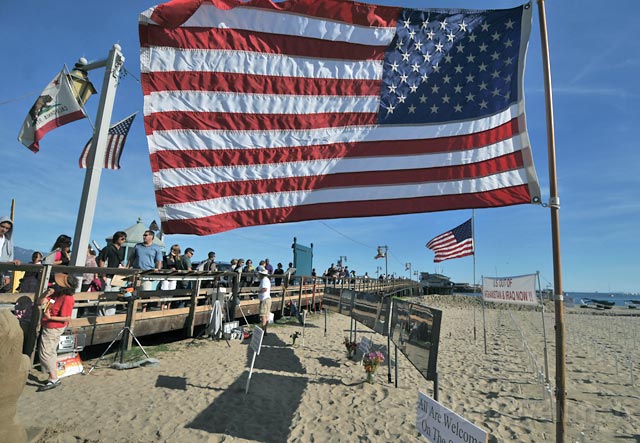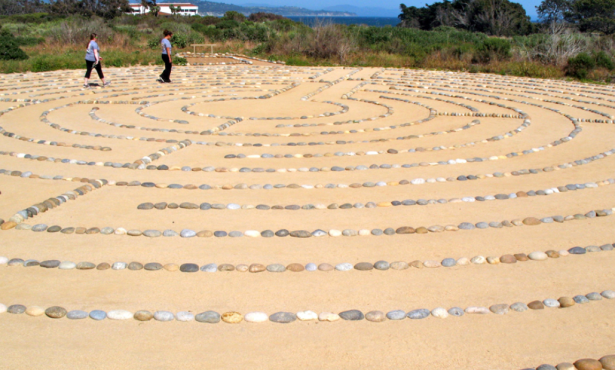Vietnam Memorial Inspires Arlington West Makeover
Veterans for Peace Downsize and Turn Focus to Afghanistan

Daniel Seidenberg, president of Chapter 54 of Veterans for Peace (VFP), suffered a seizure on the morning of November 10 — a recurring consequence of the injury he suffered in Vietnam in March 1969 when a rocket fragment slammed into his head. That didn’t stop him from spending the next Sunday morning in the sun on West Beach helping to run the Arlington West war memorial and happily pausing to show off the large concavity in his head where his right temple should be.
Arlington West has undergone a renovation in recent months. Sunday, November 14, was the second appearance of a black wall on stilts meant to recall the Vietnam War Memorial in Washington, DC. The wall faces the pier and on it are listed the names of all the casualties of the Iraq war in order of month killed.

Ron Dexter, the wall’s creator and member of VFP, chose the Vietnam War Memorial as a template because it “is probably the most famous memorial that does not reflect the glory and gore of war. It is a place of healing.”
Dexter, a veteran of the Korean War as well as the television advertising industry, built the wall out of plywood that resembles the wooden panels called flats used to create television and movie sets in Hollywood. The names of casualties are printed in white on black paper, courtesy of Bill’s Copy Shop.
The local chapter of Veterans for Peace made a decision, after the formal close of combat operations in Iraq, to shift the focus of the memorial to the war in Afghanistan. Originally, they set up crosses in rows for each of the soldiers killed in the Iraq War. They stopped adding crosses after 3,000 when they ran out of storage space. Now there are only 1,384 crosses, representing the casualties of the Afghanistan war.
That decision did not come without dissent. Steve Sherrill, who built the crosses and first put them on the beach seven years ago, said he was blindsided. “I had no idea it was something people were even talking about,” said Sherrill about a vote by a show of hands to change the memorial. “It felt like stepping off a curb and getting hit by a bus.”

Ron Dexter of Veterans for Peace said that, along with a desire to focus on the ongoing war, there were logistical constraints to putting up 3,000 crosses. “We used to get 35 volunteers” to help erect the memorial on Sundays, said Dexter. “Now if we get 15 it’s quite a crowd. Sometimes we only get seven or eight.”
“That’s a phony argument,” said Sherrill, who is still smarting from the decision. He said that it sometimes took longer to put up the crosses, but that it always got done.
Despite their difference of opinion, both the continuing volunteers and Sherill emphasized their mutual respect for each other. Sherill said, “These are good people, they are working hard for peace in the world and they deserve the support of the community.” Still, he believes that what is on the beach now should not be called Arlington West anymore.
Lane Anderson, a volunteer and Vietnam vet, said that Arlington West is a “community assemblage” which “demonstrates the cost of war which belongs to all the citizens of Santa Barbara,” before approaching a young family looking at the memorial from the pier. He handed the mother a card with advice on how to help veterans who have PTSD after she told him about a relative who fought in both Iraq and Afghanistan.

Seidenberg, Anderson, and Dexter were all working the pier, chatting up the tourists who stopped to look at Arlington West and handing out informational cards.
If the number of volunteers has dwindled since Arlington West first went up, so have the number of visitors. “Nobody takes me to task anymore,” said Anderson, almost suggesting that he’d be happy to have more people take interest in the memorial, even if they disagree with its anti-war message.
Dexter blames the price of gas, but it’s clear that the wars are no longer front and center in the public consciousness, perhaps because of the economy or because after several years of both conflicts, they have become a normal part of life.
Even the VFW members, ardent peace activists, wonder whether war is inevitable. They debate the reasons that we are still fighting in Afghanistan and Iraq — an apathetic public, the inability of soldiers to evade their orders as they could in Vietnam, the immense amount of money made in war profiteering, oil. Still, they persevere. On the first Sunday of every month, they erect Arlington West and try to win converts. (They plan on erecting the memorial both of the remaining Sundays in November as well.)
“The process of struggle matters,” said Anderson. He feels like peace activists have won small victories. For instance, “Support the troops no longer means support the war.”
Seidenberg said he volunteers to “fight the frustration.” He is a bit nostalgic for the heyday of the Vietnam War protests when the public was outraged to extent of destruction. (He participated in the burning of the Bank of America building in Isla Vista in 1970.)
He might have found a bit that outrage in Alfred Nichols, a tourist and Vietnam War veteran who stopped at the base of the pier to look at the Arlington West memorial around 11 a.m. “I appreciate people paying homage to soldiers who died,” said Nichols. Then he went on question the point of the Vietnam War. “Now everything we buy is made in Vietnam,” an inchoate rage boiling to the surface. “And now they want to raise the retirement age to 69,” he added as his wife tugged him along Stearns Wharf by the elbow, trying to pull him away from his anger and back to his vacation.



